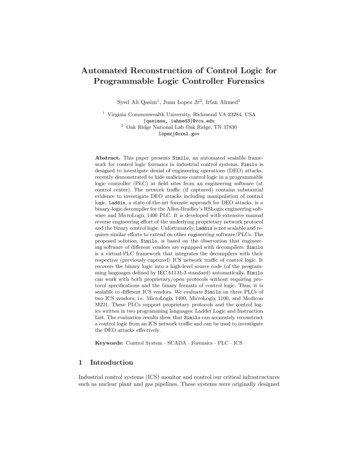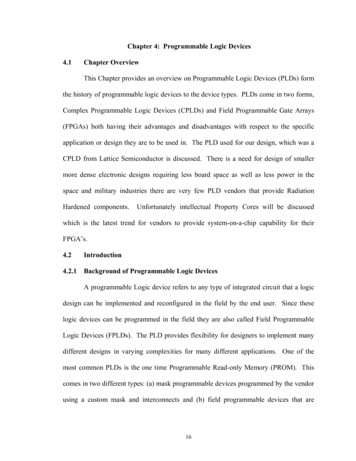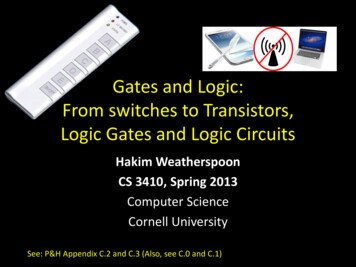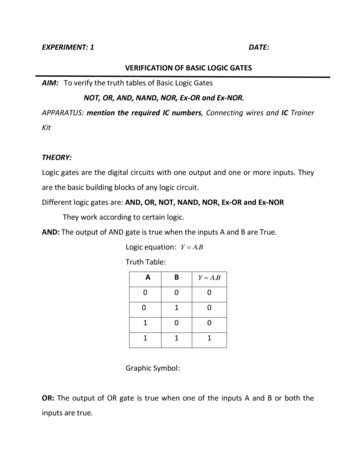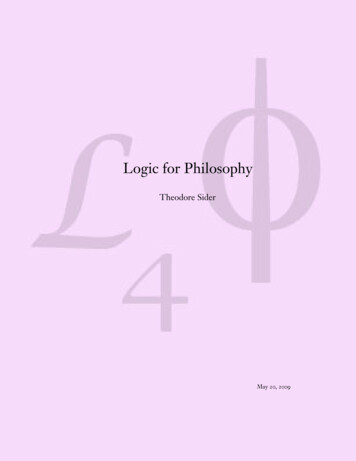
Transcription
Formal Logic and Grouping Games One related image goes hereImage adapted from Xiaojun Deng via flickr.com under CC BY 2.0
Overview of the Webinar The scope of formal logic on the LSAT Introduction to Conditional Logic Compound Conditionals ContrapositivesFallacies of Conditional LogicA Conditional Logic drillWhere you will encounter Conditional LogicIntroduction to Grouping GameGrouping Game DrillWe’ll stop every half hour for questionsWe appreciate you being here!This information can be found in evenmore depth in our free course
What is Formal Logic?The LSAT is not nearly this complicated!
What is Formal Logic? Formal logic is a way of symbolizing relationships expressed in language. As we saw on the last slide, it can get pretty complicated! The LSAT only a handful of formal logic ideas
Formal Logic Tested on the LSAT There are a handful of notions that are rarely testedMostSome, Many, SeveralNot AllWe cover these in our “Vocabulary of Formal Logic” video in Lesson 6 ofthe LSAT course, but they only rarely come up on the test.But there is one type of relationship that the LSAT always tests, and it willtest it in a couple of different ways .
Introduction to Conditional Logic The only concept of formal logic routinely tested on the LSAT iscalled conditional logic. Conditional logic is tested in four different ways, and we’ll coverthe most common and fundamental expression of a conditionaltoday. Conditional logic expresses “If, then,” relationships, such as: “If I am in Boston, then I am in New England.” “If I am not in California, then I am not in Los Angeles” “If I am in Brooklyn, then I am not in Queens.” Each one of these is a conditional statement, and thus each oneof these can be diagrammed using a conditional arrow.
The Conditional Arrow The conditional arrow is how we express conditional relationships in aneat and efficient way. Conditional arrows always have the same fundamental structure:If Then
Using the Conditional Arrow Let’s look back at our examples from a previous slide. “If I am in Boston, then I am in New England.”If in Boston Then in New EnglandIf Boston Then New England But if we remember that the term on the left is always the if term, andthe term on the right is always the then term, we can eliminate thosewords from the conditional.Boston New England And if we can remember that “B” means Boston and “NE” means NewEngland, then we can write a very short diagram that exactly conveys theconditional:B NE
Negatives in Conditionals The second and third examples that we gave you on a previous slide bothuse “not.” There are a few ways to diagram not: You can use tildes. For example:If Not US Not LA becomes US LA You can also cross the terms outUS LA
Some Facts About the Contrapositive. A fancy sounding work! Say it to your friends, and they’ll know you’reserious about the LSAT. The Contrapositive is a logical inference that can be always be drawnfrom any conditional statement. An inference is something that must be true based on the informationgiven (you’ll face inferences on all three sections of the test) This is remarkable only because many statements have no inferencesthat are reliably true, while the contrapositive is always true in anyconditional statement. Every single modern LSAT, going back to LSAT #1, tests your ability todraw contrapositives in one form or another.
How to Find the Contrapositive There are three steps to finding a contrapositive, but the third isirrelevant for us so far. Let’s take two of our examples: To find the contrapositive flip the statements Then, negate the statements. The contrapositive of “If you are in Boston, then you are in NewEngland.”B NE Is “If you are not in New England, then you are not in Boston.” NE BAnd it’s even true!
Contrapositives and NegationsB NE becomes NE BBut what about our other two examples: “If I am not in the US, then I’mnot in LA” and “If I’m in Brooklyn, then I’m not in Queens”? US LAandB QJust when you multiply negatives in math, two negatives make a positive.To find the contrapositive, we flip the statements and negate them, whichmakes some terms positive. They become:LA USQ B
Simple and Compound Conditionals So far, we’ve looked at Simple Conditionals. Simple conditionals onlyhave two terms. Conditionals that have more than two terms are called CompoundConditionals, and those terms are bound with the words And and Or.For example:“If I am in the Twin Cities, then I am in Minneapolis or St. Paul”“If I’m in a good mood and you’re quiet, then I’ll tell you a story.”Each of these conditionals has three terms (Twin Cities, Minneapolis, St.Paul) and (Good Mood, Quiet, and Story).
Diagramming Compound Conditionals Compound Conditionals are diagrammed just like simple conditionals: “If you live in the Twin Cities, then you live in Minneapolis or St Paul” isMTC orSt. P “If I’m in a good mood and you’re quiet, then I’ll tell you a story”GMand SQ
Quick Note On “Or” on the LSAT “Or” has two senses in English: exclusive and inclusive Exclusive Sense of Or: “You can make a left or a right up here, it doesn’tmatter which.” This means “Left or Right, but not both.” Inclusive Sense of Or: “Thanks for coming. Would you like something todrink or eat?” This means “Drink or eat or both Unless noted otherwise, the LSAT always means inclusive or. Every timeyou see “or” in a formal logic situation – in LR or LG – itSo “You live in Minneapolis or St Paul” in the previous example can mean“or both.” (Maybe you live in more than one place?)
Contraposing Compound Conditionals The first two steps of our contrapositive apply to compound conditionals:flip and negate. There’s a third step introduced here: Every “And” becomes “Or,” andEvery “Or” becomes “And.”MGMand STC orQStPBecomesBecomes GM M S orand TC Q StP
Drill! You’ll find these ten questions on your handout. You can also just copy from thescreen. Diagram each conditional and its contrapositive1) If the cruise goes to Jamaica, then it won’t go to Trinidad.2) If the interview is room #2, then it won’t be in rooms #1 or #3.3) All of the students at this law school did well on the LSAT.4) None of my friends are here.5) I can’t focus if you’re going to play video games or watch a movie.6) All of your employees must wear goggles in order to follow procedure.7) Each of the students achieved a passing mark8) If you are a properly licensed JD and you practice law, you’re a lawyer9) You’d be a fool not to take that deal!10) I can bake the cake only if I have eggs and butter
Drill Solutions Page 11) If the cruise goes to Jamaica, then it won’t go to Trinidad.2) If the interview is room #2, then it won’t be in rooms #1 or #3.3) All of the students at this law school did well on the LSAT.4) None of my friends are here.5) I can’t focus if you’re going to play video games or watch a movie.
Drill Solutions Page 26) All of your employees must wear goggles in order to follow procedure.7) Each of the students achieved a passing mark8) If you are a properly licensed JD and you practice law, you’re a lawyer9) You’d be a fool not to take that deal!10) I can bake the cake only if I have eggs and butter
Where will you face conditionals on the LSAT? Two places: Logic Games and Logical Reasoning In Logical Reasoning, “Formal Logic” Prompts willoften test conditional relationships. You may seesomething like:“All of the students in the history major are in thehistory club. All of the members of the history clubpay annual dues and attend monthly meetings.” You’ll also frequently see conditionals in LogicGames, specifically in .
Grouping Games!
The Key Skills of Logic Games The LG section of the LSAT tests your ability to order and think throughrelationships and structures. There are three key skills. Sequencing – putting things in order. This is a key skill. Check out Lesson 1 ofour free LSAT course for more information. Matching – attributing qualities to certain variables. Check out Lesson 7 of ourfree LSAT course for more information. Grouping – sorting variables into groups. We’ll be doing these together today,but you can also check out Lesson 4 of our free LSAT course.
Grouping Games Ask You To Sort elements into different categories. If the primary aim ofa linear game is sequencing, then the primary aim of agrouping game is sorting. These games – more than any other – tend to heavilyfeature conditional logic in the rules. Let’s take a look at how grouping games are going to showup on the LSAT
Basic In/Out GroupingNine musicians – M, N, O, P, R, S, T, U, and X – are auditioning for an ensemble.Five will be selected. The following conditions apply: This is a “Basic” Grouping Game. Two groups: Included and Excluded. We’lldiagram it like this:In:Out:Note: Always diagram the excluded category! Keep track of those who are out.
Two Separate GroupsOf six applicants – G, H, I, J, K, and M –, four will attend Birmingham Law Schooland two will attend Chester Law School. No student attends both, and everystudent must one or the other. The following conditions apply:This is effectively the same as the last game!B:C:Both this game and the last game are binary gamesIf you aren’t in, you’re out.If you aren’t at Birmingham, you’re at Chester.
Fixed Number v. Variable NumberEach of six applicants – G, H, I, J, K, and M – will attend either Birmingham LawSchool or attend Chester Law School. No student attends both, and every studentmust one or the other. Each law school is attended by at least one of theapplicants. The following conditions apply:B: ( ) ( ) ( ) ( )C: ( ) ( ) ( ) ( )Still a binary game, but the variability makes it a little bit trickier.
Three or More GroupsThe eight members of the Cadwell family – D, E, F, G, H, I, J, K, and L – will stay inthree different hotel rooms during their vacation. Each hotel room is occupied byat least one family member, and no family member stays in more than room.Here, we don’t get room numbers or names. We also get three separate groups. We can be surethat the rules of this game are going to have a lot more to do with which family members areclustered together than where specifically they go.1:2:3:
Rules in In/Out GroupingNine musicians – M, N, O, P, R, S, T, U, and X – are auditioning for an ensemble.Five will be selected. The following conditions apply:If M is selected, then N is not selectedIf O is not selected, then P must be selectedP and R are either both selected, or neither isIn:Out:
Fixed Number v. Variable NumberEach of six applicants – G, H, I, J, K, and M – will attend either Birmingham LawSchool or attend Chester Law School. No student attends both, and every studentmust one or the other. Each law school is attended by at least one of theapplicants. The following conditions apply:If G attends Birmingham, then K must attend ChesterIf I attends Chester, then J and M must, tooB: ( ) ( ) ( ) ( )C: ( ) ( ) ( ) ( )
Drill Question Number 1Seven dogs – S, T, U, W, X, Y, Z – will be adopted by two different owners, R andQ. Each dog will be adopted by one of the two owners, and no dog will beadopted by both. The following conditions apply:If S is adopted by R, then T is adopted by R.U and W cannot be adopted by the same owner.If X is adopted by Q, then T is adopted by Q.
Drill Question Number 2A law firm is interviewing seven candidates – F, G, H, I, J, L, and M – to fill threepositions at the firm. The following conditions apply:If F is not hired, then J and L are hired.If H is hired, then F is hired.M and L must both be hired, or neither is.
Drill Question Number 3Eight books – one each on agriculture, business, culture, dendrology, economics,fine art, geology, and humanism – will be sorted onto three different shelves. Thefollowing conditions apply:At least two books and no more than three books are on each shelf.The books on fine art and culture must be on the same shelfIf the book on agriculture and dendrology are not together, then thebooks on economics and business are.
Drill Question Number 4Six mountaineers – M, N, O, P, Q, and R – will form teams of two to scale threepeaks – A, B, and C. The following conditions apply:R cannot climb Peak CO and R cannot climb the same mountain togetherIf O climbs B, then P climbs C.If N climbs A, then so does Q.
Free LSAT Office HoursLSAT Formal Logic andGrouping GamesAugust 24th @ 7pm ETConclusions and Assumptionsin Logical ReasoningSeptember 21st @ 7pm ETReading ComprehensionPassages and QuestionsOctober 26th @ 7pm ET
Have you heard about ourFREE LSAT COURSE? Includes 20 hours of lesson videos providing comprehensiveLSAT review Lesson Handouts provide guidance and explanations of realLSAC questions Beta program currently running – participate for your chance towin free books and other prizesnextsteptestprep.com/lsat-course-online/
The Next Step LSAT Process FREE consultation PERSONALIZED tutormatching CUSTOMIZED Study Planthat changes as you improve
Unbeatable Value Best Possible LSAT Prep Customized Study Plans Superior Quality Top National TutorsNext Step Test Prep16 Hours Tutoring 1,49924 Hours Tutoring 2,099PrincetonKaplan24 HoursTutoring 3,600 15 HoursTutoring 2,599
Why is tutoring right for you?Have a packed schedule, so looking fora flexible, customized schedule.Started self-studying or took theLSAT and need a restart.Setting your sights on a high score andtop law school.
Questions?Learn more at:http://nextsteptestprep.com/LSATOr contact us anytime at:Info@NextStepTestPrep.com888-530-NEXT
Formal Logic Tested on the LSAT There are a handful of notions that are rarely tested Most Some, Many, Several Not All We cover these in our "Vocabulary of Formal Logic" video in Lesson 6 of the LSAT course, but they only rarely come up on the test. But there is one type of relationship that the LSAT always tests, and it will



